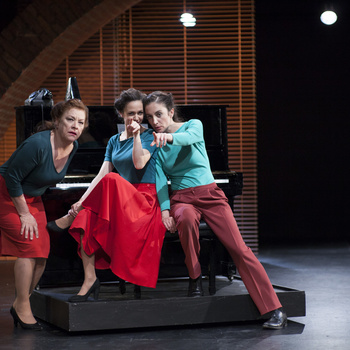Hitchcock
Mladinsko Theatre
Schedule
Première 20 April 2017, Lower Hall of the Mladinsko Theatre
Running time approximately 1 hour 20 minutes. No interval.
Creators
Agnieszka Jakimiak (text and dramaturgy) • Katarzyna Leks (set and costume designer) • Agata Maszkiewicz (choreographer) • Weronika Szczawińska (director) • Piotr Wawer Jr. (dramaturgy and music selection)
Translator Tatjana Jamnik
Language consultant Mateja Dermelj
Sound designer Silvo Zupančič
Lighting designer David Cvelbar
Interpreter in rehearsals and prompter Špela Kopitar
Consultant Matjaž Marinič
Make-up artist Nathalie Horvat
Stage managers Janez Pavlovčič, Gašper Tesner
Cast
Primož Bezjak • Damjana Černe • Daša Doberšek • Draga Potočnjak • Matej Recer • Katarina Stegnar
The production is supported by the Embassy of the Republic of Poland in Ljubljana.
Is it so that each film viewer sees the same thing on the screen? If we revisit Hitchcock’s films it turns out that the memories of our previous viewings mingle with the present expectations. The scenes that other film makers have borrowed from the Master of Suspense alter our grasping of the original; the notion of his creativity influences the film’s current interpretation. If we take an even closer look at Hitchcock’s films we might notice that they are much more entertaining, weird and
atypical than we were perhaps used to thinking.
The focus of interest of the production Hitchcock is what escapes control in Hitchcock’s films and the interviews with Hitchcock. We inspect a typical Hitchcock blonde that shifts away from the Hitchcock blonde type, and the master of cinema who doesn’t fulfil the requirements assigned to the master status. Hitchcock’s cinema is a factory of often unrecognised and contradictory emotions as well as a space in which strictly determined identities – female, male, star, author – crack in
two and manifest their disharmonies.
We can certainly speak of a fresh and specific directorial aesthetics brought to the stage by the young Polish team […]. By that we don’t mean a deliberately restrained aesthetic imagery of film classics from half a century ago […]. The aesthetics is mostly in the extraordinary composition of the stage through the choreography of bodies and props that is the equivalent of the way Hitchcock created his film imagery, as well as in the question of how to convey a message through the constellation of bodies and the construction of the stage image.
Nika Arhar, Delo, 25 April 2017



